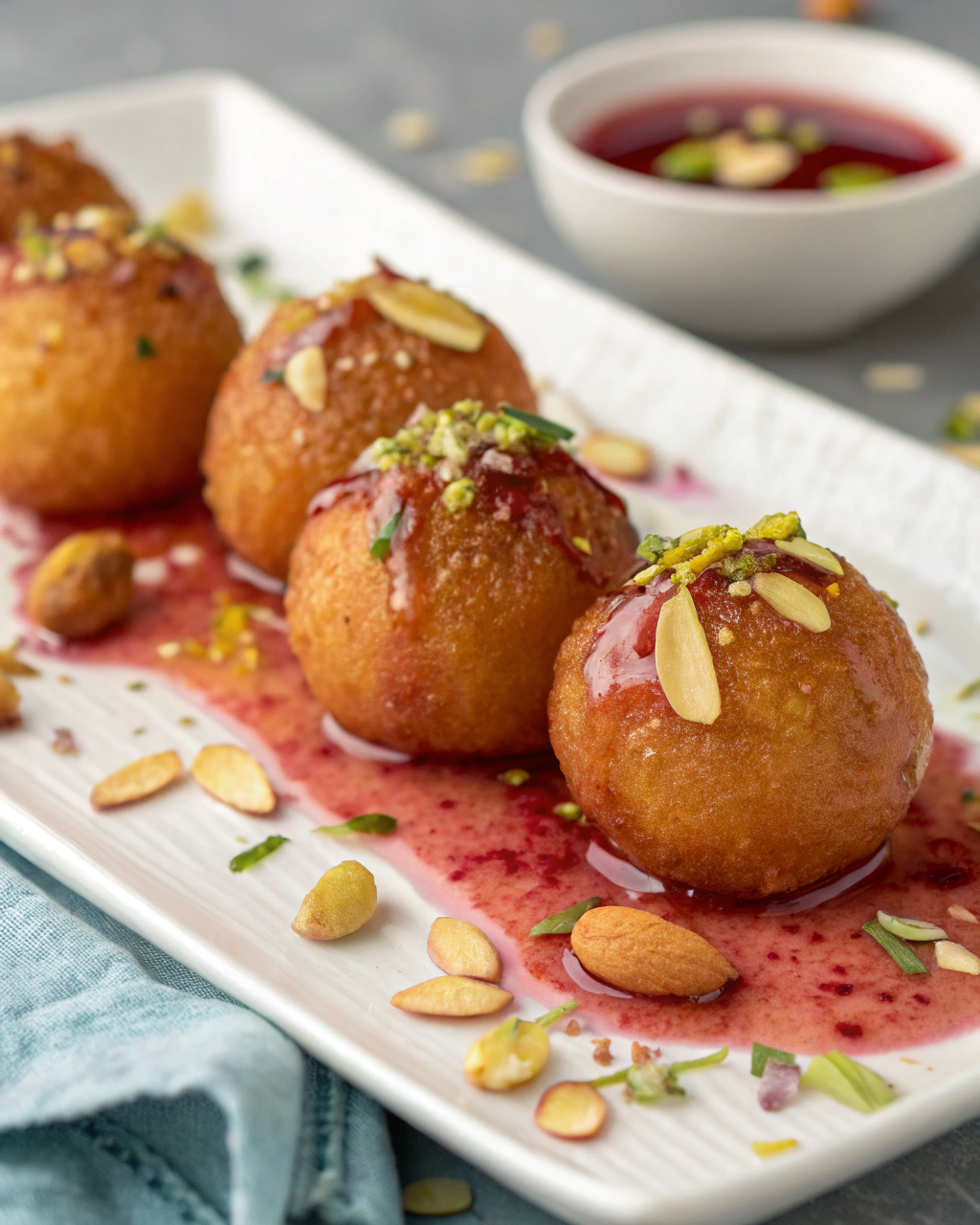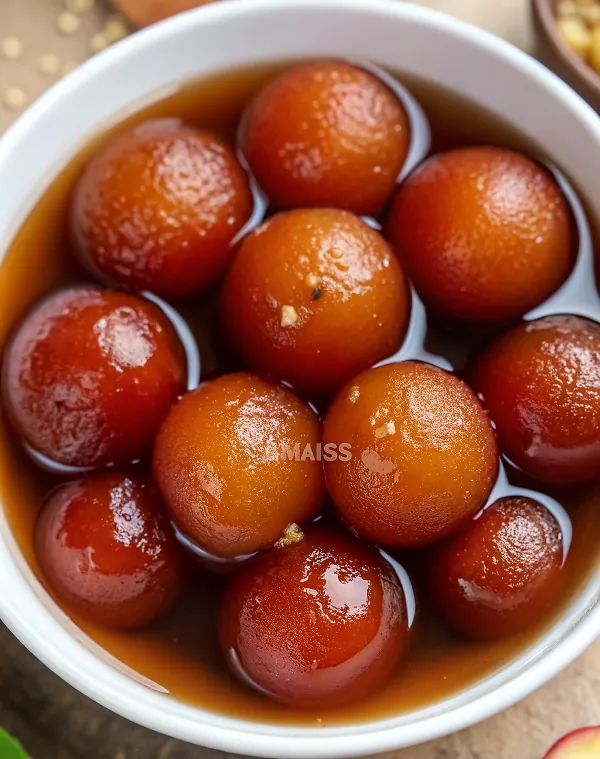Did you know that over 80% of Indian households serve Gulab Jamun during festivals and celebrations? This beloved dessert has captured hearts worldwide with its perfectly spongy texture and aromatic sugar syrup. Whether you’re planning a special dinner or simply craving something sweet, this Gulab Jamun recipe will transform your kitchen into an authentic Indian sweet shop. These golden, syrup-soaked dumplings might seem intimidating at first, but with the right technique and ingredients, you’ll master this classic dessert in no time. Get ready to impress your family and friends with these melt-in-your-mouth delights that pair beautifully with chai or vanilla ice cream.
Why Perfect Gulab Jamun Matters
Creating authentic Gulab Jamun requires understanding the delicate balance between texture and flavor. The perfect dumpling should be light, spongy, and evenly soaked with fragrant syrup. This recipe ensures consistent results every time, avoiding common pitfalls like dense, rubbery balls or overly sweet coating. Mastering this traditional technique opens doors to countless variations and gives you confidence to tackle other milk-based Indian desserts.
External Resources
For more inspiration on traditional desserts, explore our Apple Crisp Cheesecake and Chess Pie recipes. You can also check out this detailed Milk Powder Barfi Recipe video for more milk-based sweets, or discover 19 Fried Desserts that capture that same indulgent, fair-like quality as these golden treats.
Ingredients
Gulab Jamun ngredients

|
Ingredient Spotlight
Dry milk powder forms the foundation of authentic Gulab Jamun, providing the characteristic dense yet tender texture. Ghee adds richness and helps create the golden color during frying. Cardamom provides the signature aromatic warmth that distinguishes homemade versions from store-bought varieties. The rose water in the syrup creates that distinctive floral fragrance that makes these dumplings truly special. Baking powder ensures the balls puff up properly during frying, creating the perfect spongy interior.
Timing
|
Instructions
|
Tips & Tricks for Perfect Gulab Jamun
|
Recipe Variations & Substitutions
Chocolate Gulab Jamun: Add 2 tablespoons cocoa powder to the dry ingredients and reduce flour by 1 tablespoon. The rich chocolate flavor pairs beautifully with the cardamom syrup.
Coconut Version: Replace half the milk powder with desiccated coconut and add coconut milk instead of regular milk. This creates a tropical twist on the classic.
Vegan Alternative: Use coconut milk powder instead of dairy, replace ghee with coconut oil, and use plant-based milk. The texture remains surprisingly authentic.
Sugar-Free Option: Create the syrup using sugar substitute and add extra rose water and cardamom for flavor depth. Perfect for those watching their sugar intake.
Behind the Recipe
This Gulab Jamun recipe draws inspiration from the traditional mithai shops of Old Delhi, where master sweet makers have perfected these golden spheres for generations. The technique of using milk powder instead of fresh khoya makes this version accessible to home cooks worldwide, while maintaining the authentic taste and texture. The addition of optional nuts and raisins reflects the Mughlai influence on Indian sweets, creating little treasures within each bite. Every element, from the precise timing to the aromatic syrup, honors the centuries-old tradition while adapting to modern kitchens.
Pairing Ideas
Serve warm Gulab Jamun alongside a steaming cup of masala chai or cardamom tea to enhance the aromatic spices. For special occasions, pair with vanilla ice cream or kulfi for a delightful temperature contrast. These sweets complement other Indian desserts like kheer or ras malai beautifully on a festive platter. During celebrations, arrange them with fresh rose petals and chopped pistachios for an elegant presentation. The floral notes also pair wonderfully with jasmine green tea or even coffee for an unexpected but delicious combination.
Leftover & Reuse Ideas
Transform leftover Gulab Jamun into an indulgent bread pudding by layering pieces with custard and baking until golden. Chop cooled jamuns and fold into vanilla ice cream for a unique frozen dessert. Blend them into milkshakes or smoothies for instant sweetness and flavor. Create elegant trifles by layering crumbled jamuns with whipped cream and fresh fruits. For a modern twist, slice them in half and use as a base for sweet sandwiches filled with ricotta and honey. They also make excellent additions to fruit salads, adding richness and exotic flavors.
Nutritional Information
Each Gulab Jamun contains approximately 165 calories, with 8 grams of fat, 22 grams of carbohydrates, and 4 grams of protein. The milk powder provides calcium and protein, while the moderate portion size makes them a reasonable indulgence. The recipe yields 20 servings, making it perfect for sharing during celebrations. The nuts add healthy fats and additional protein when included. For a lighter version, you can reduce the syrup soaking time or serve smaller portions alongside fresh fruit.
Serving Suggestions
Present Gulab Jamun warm in individual bowls drizzled with extra syrup and garnished with chopped pistachios and rose petals. For formal dinners, serve two pieces per person with a small spoonful of thickened cream or a quenelle of vanilla ice cream. During festivals, arrange them on silver platters with other traditional sweets for an authentic display. Family-style serving works well with a large bowl and individual spoons, allowing everyone to enjoy them at their preferred temperature. Consider serving with thin coconut wafers or delicate butter cookies for textural contrast.
Common Mistakes to Avoid
Dense, Heavy Jamuns: This happens when too much flour is added or the dough is overworked. Measure accurately and mix just until combined.
Breaking During Frying: Cracks in the shaped balls cause this issue. Ensure your dough is properly hydrated and roll gently without pressure.
Uneven Browning: Oil temperature that’s too high or overcrowding the pan causes this. Maintain steady medium-low heat and fry in small batches.
Not Absorbing Syrup: Cold syrup or overcooked jamuns prevent proper absorption. Keep syrup warm and avoid overcooking the dumplings.
Too Sweet or Bland: Incorrect syrup consistency affects flavor balance. Taste and adjust rose water and cardamom as needed during cooking.
Storage & Reheating Tips
Store Gulab Jamun in their syrup in the refrigerator for up to 5 days in an airtight container. For longer storage, freeze them in syrup for up to 2 months – they thaw beautifully. To reheat, warm gently in the microwave for 15-20 seconds or place in a warm oven for 5 minutes. The syrup can be stored separately and rewarmed if needed. For best texture, bring to room temperature before serving if stored cold. Avoid storing at room temperature for more than 4 hours due to the milk content. Always use clean utensils when serving to prevent contamination.
FAQs
- Are Gulab Jamun gluten-free?
- Traditional Gulab Jamun contains all-purpose flour, so they’re not gluten-free. However, you can substitute with almond flour or gluten-free flour blend for a suitable alternative.
- How do I know when Gulab Jamun are properly cooked?
- Properly cooked Gulab Jamun will double in size, float to the surface, and have a light golden color. They should feel firm but springy when gently pressed with a spoon.
- Can I make Gulab Jamun ahead of time?
- Yes! Gulab Jamun actually improve in flavor when made ahead. They can be prepared up to 2 days in advance and stored in syrup in the refrigerator. Serve at room temperature or gently warmed.
- Why are my Gulab Jamun hard instead of soft?
- Hard Gulab Jamun result from too much flour in the dough, overcooking, or oil that’s too hot. Ensure proper measurements, gentle frying, and adequate syrup soaking time.
- What’s the best oil temperature for frying Gulab Jamun?
- The ideal temperature is medium-low, around 325°F (165°C). The oil should gently bubble around the jamuns without violent sizzling. Too hot and they’ll cook unevenly; too cool and they’ll absorb excess oil.
Conclusion
Gulab Jamun

These heavenly Gulab Jamun bring the authentic flavors of Indian confectionery right to your kitchen. With their perfectly spongy texture, aromatic cardamom-rose syrup, and golden appearance, they’re sure to become a favorite for special occasions and everyday indulgences alike. The key lies in patience during the frying process and allowing proper time for syrup absorption. Whether you’re celebrating Diwali, hosting a dinner party, or simply treating yourself, this recipe delivers consistently delicious results that rival the best sweet shops.
Made these Gulab Jamun? Drop your twist in the comments, rate the recipe, and tag us on facebook, instagram with #erinrecipes — we might feature your creation!

Perfect Gulab Jamun Recipe: Traditional Indian Sweet Delight
Ingredients
Instructions
- Prepare dough: In a large bowl, stir together the milk powder, flour, baking powder, and cardamom. Stir in the almonds, pistachios and golden raisins. Mix in the melted ghee, then pour in the milk, and continue to mix until well blended. Cover and let rest for 20 minutes.
- Make syrup: In a large skillet, stir together the sugar, water, rose water and a pinch of cardamom. Bring to a boil, and simmer for just a minute. Set aside.
- Fry balls: Fill a large heavy skillet halfway with oil. Heat over medium heat for at least 5 minutes. Knead the dough, and form into about 20 small balls. Reduce the heat of the oil to low, and fry the balls in one or two batches. After about 5 minutes, they will start to float, and expand to twice their original size, but the color will not change much. After the jamun float, increase the heat to medium, and turn them frequently until light golden. Remove from the oil to paper towels using a slotted spoon, and allow to cool.
- Soak in syrup: Place the balls into the skillet with the syrup. Simmer over medium heat for about 5 minutes, squeezing them gently to soak up the syrup. Serve immediately, or chill.
